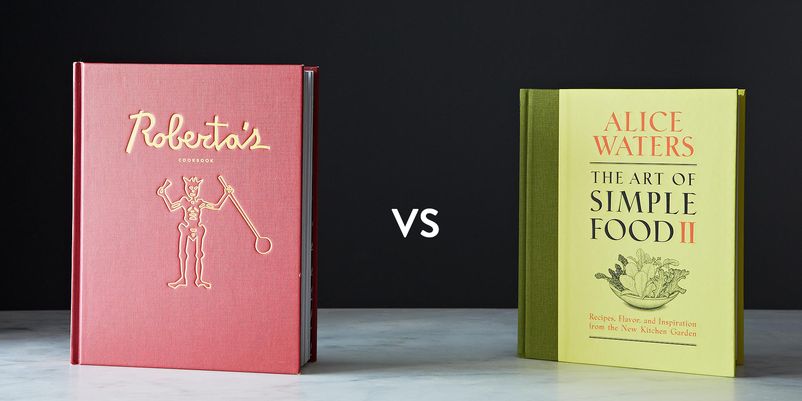So my pal Charlotte asks me to review a couple of cookbooks, which is a stretch, because although I do like to cook and I enjoy a great meal at a great restaurant and will even go so far to seek out such experiences, I am not a chef nor a particularly acute observer of tastes and smells and textures beyond the narrow province of I know what I like.
In 30-plus years of cooking I can claim credit to a passable pie pastry and, in just the last few months, mind you, I’ve finally learned what it means to barbecue (slow smoke, not grill) a decent side of ribs.
But, hey, why not? This is going to be fun, and I’m going to cheat because I’m going to get my wife, Hilary, to help. She’s a bona fide foodie, loves (not likes) to cook, and is damn good at it. She is also utterly fearless and experiments with abandon. The meals I eat at home could grace the menus of a fleet of highly sought-after food trucks, each different, with Twitter followers and everything.
When I announce the task, I see dueling forces of skepticism and curiosity dapple across her brow. But all doubt is gone once the books arrive.
I’m such a food plebe I’d never even heard of Roberta’s, but Alice Waters is of sufficient legend. I have heard of her. Not to gloat. Anyone who lives in San Francisco exists by default within her spirit orbit on some level, and quite possibly every level. In my house, it is the latter. Hilary worships at the church of Alice, and we’ve paid due respects at Chez Panisse. Way to go with the whole school meals charity thing. All hail. When I open the packet, I sort of feel sorry for Roberta’s, actually.
But not for long because these guys totally rock! The cookbook doubles as an autobiography of their restaurant, which began life as a windowless cinderblock pizza structure (there is no other word for it) in Bushwick. They are rebels, outlaws even, quite literally, as some of their ingredients can only be acquired by smuggling (pro tip: put the cheese in your socks). They built a dirt bike track in their rooftop garden. They like to drink as much as they like to eat. And they know how to tell a fucking story. (Note to eds: That fuck is legit. Read the book.)
In the spirit of Roberta’s, Hilary declares we’ll use it to prepare the food for our annual Halloween drop-in party. We live around the corner from Fair Oaks Street in San Francisco, a veritable trick-or-treat mecca, drawing in thousands of visitors every year. We’ll hit the pizza menu and some sides. The salt-roasted beets immediately grab her attention. What did I say? Fearless.
Now a short digression: If you wanted to create a fictional foil for Alice Waters, you’d have to invent Roberta’s. These guys love to smoke pot and drink shots…in the restaurant…while it is open for business…with their customers. They cop a motorcycle gang style, which for all I know is completely authentic. They claim to have zero professional experience and are completely self-taught. They break the law and brag about it. And, despite all of that, their philosophy of food is not all that far from Alice Waters. The two are actually identical: Great dishes are discovered, not made, by using the freshest perfect ingredients grown by yourself in your own garden. That’s as hard to argue against as it is hard to live by.
Anyway, back to the story: It’s the day before the big day, and Hilary is royally pissed because you can’t actually buy some of the Roberta’s Cookbook ingredients in San Francisco. Substitutions must be made. The authors have not been kind enough to suggest more common alternatives, a situation declared to be “ridiculous.” I cannot disagree, yet the meal must go on, and so it does.
Pizza dough is amassed. Substitutions are acquired. Halloween costumes are fitted out. Our front door is propped open and we cook as the house fills with the comings and goings of neighbors and friends.
The Roberta’s pizza dough is dreamy. The best I’ve ever made at home, and I’ve tried plenty. With a stone in the oven at 500 degrees it came out crispy on the outside and chewy on the inside. Handling it was a bit tricky and the first attempt stuck to the peel, leaving a piled-up mess. But I got the hang of it, and the next few slid in and out no problem.
The results of the toppings were mixed, most notably in the proportions, which were on the light side, leading to some skimpy and flavor-lite pies. But to be fair, few seemed to notice. Adults and kids lined up and ate it all.
The Caesar salad was magnificent, with roasted garlic and candied walnuts. But by far the most impressive recipe of the night was the salt-roasted beets. I first encountered this technique in Tokyo, at a meal hosted by the organizers of a tech conference I was invited to judge, involving some kind of mountain potatoes that yielded a fluffy paradise that melted in the mouth. You’ll never find this on the menu at the neighborhood sushi joint. When Hilary took the chance to try this technique at home, I was alert to the possibilities. It did not disappoint. Whites from twelve eggs were folded into a kosher salt paste that covered the beets as they roasted to perfection, concentrating all of the flavors and leaving none to drip out in the pan. Minutes after extracting them from their salty-egg tombs, the plate was picked clean.
Now sacrilege: Following Roberta’s with Alice was an anticlimax. I absolutely appreciate the beauty of fresh perfect produce. One of the most gastronomically orgasmic experiences of my life was eating a sliced orange. That’s it: An encounter between an orange and a knife. The Art of Simple Food II preaches that gospel, in a finely crafted volume with beautiful line drawings of garden fresh vegetables.
Start with a perfect tomato. Add sea salt and pepper, and you can’t do anything else to improve it. Yes. Growing your own produce and harvesting it at the peak of flavor is probably going to do more for the quality of your eating experience than anything else you might do. It’s a way of life, not a recipe, and that is where Alice disappoints. Simple recipes work wonderfully with awesome ingredients, but the sparseness of the preparation in this cookbook ultimately is bound to be a let down for the average home cook, and it my case, it was. It is hard to cook a full meal from this book, and the results can be just so-so if you’ve come to the kitchen from the supermarket instead of your own lovingly tended organic plot.
Hilary made the Leek Tart with Crème Fraîche and Bacon, which was nice with a flaky crust and, well, bacon, plus leeks are an under-appreciated knock-out in almost anything.
Our Butternut Squash and Celery Root Gratin, on the other hand, came out almost inedible, runny and not quite done. I’m happy to take the bullet on that one, blame the cook not the recipe. Maybe blame the squash. Or the celery root. Or blame the Whole Foods, where we bought them? Or blame the half and half, or the cream? The marjoram? The salt? The cayenne? That’s the whole list of ingredients, by the way, so we’re running out of things to throw under the bus here. Alice? Never. I think we’re back to the cook.
Hilary!



82 Comments
"Our Butternut Squash and Celery Root Gratin, on the other hand, came out almost inedible, runny and not quite done."